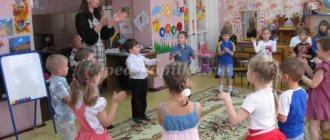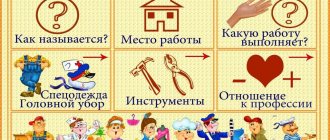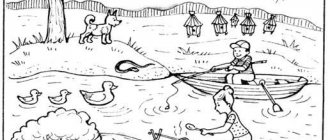Senior group. Senior preschool age. Children 5-6 years old
Summary of a logorhythmic lesson for children of senior preschool age “Housewarming in the forest” Logorhythmic lesson for children of senior preschool age “Housewarming in the forest” Purpose: Overcoming speech disorders through the development and correction of the motor and emotional spheres of the child. Objectives: Development of a sense of rhythm, attention; Development of coordination of speech, movement and music;…
Abstract of a logorhythmic lesson in the senior speech therapy group “Spring” Goals: 1. Overcoming speech disorders through development, education and correction in children with speech pathology of the motor sphere in combination with words and music. 2.Development of curiosity as the basis of cognitive activity in preschool children. 3.Formation of creative…
Open lesson on logorhythmics in the senior group
Scenario for an open lesson on Logori.
Description of the material: Every year our holding hosts Open Days, the purpose of which is to introduce parents to specialists and teachers of additional education, as well as to the methods used in working with children. We present various areas (artistic and aesthetic, creative, physical education, educational) in the form of master classes and open classes. My circle on musical logorhythmics belongs to the artistic and aesthetic cycle and, thinking through the course of the lesson, I decided to devote it to a conversation about rhythm and ways to develop a sense of rhythm in children. Author: Olga Vasilievna Podkolzina, music director of the State Budgetary Educational Institution “School No. 1056” in Moscow. Goal: To interest parents and children in the subject of logorhythmics. Objectives: introduce rhythm games; show ways to develop a sense of rhythm in a child; create a relaxed gaming atmosphere.
Progress of the event
Guests (parents with children) enter the hall to the music. Musical director: Hello, my friends, I am glad to see you all. Our garden is open to guests, parents and their children. I suggest you stand in a circle and start our fun lesson! (Everyone stands in a circle.)
And before we start, we need to greet each other.
Communication game “Hello, friend!” M.Yu. Kartushina 1. The legs walked (Children and parents move scattered around the hall.)
Straight along the path, They met a friend
(Towards the end of the verse they stand in pairs.)
Little legs.
Chorus: Hello, hello, (Holding hands, couples perform a “spring”)
Hello, dear friend, Hello, hello,
(Do a “spring”).
Look around!
(Spread their arms to the sides).
Hello, hello,
(They make a “spring”).
Smile at me!
(Pretend to smile by raising your hands to your chin.)
Hello, hello,
(They make a “spring”).
Bow your head!
(Bow to each other).
2. The legs ran
(They run on their toes scattered around the hall).
Right along the path, Met a friend
(Get into pairs).
Little feet.
Chorus. (Movements are repeated).
3. The legs jumped
(they move around the hall in jumps, kids jump on two legs).
Right along the path, Met a friend
(By the end of the verse they get into pairs).
Little feet.
Chorus. (Movements are repeated). Musical director: Well, now that we have all said hello, I would like to talk to you a little about logorhythmics, about rhythm in general and how you can play with it. What is logorhythmics? This is a system of motor exercises that are combined with words and music. Most often it is used in correctional pedagogy, as well as to stimulate the speech development of children. Rhythm is not only a musical concept, but also a sense of time in general. A good sense of rhythm helps children better master their native language, because our speech also consists of rhythmic formulas, in which stressed and unstressed syllables constantly alternate. If you transfer them to rhythm, you get an alternation of long and short durations. Let me give you an example. My name is Olga VasIlyevna. I will say my name like this - a long syllable and two short ones (ta-ti-ti), a long syllable and two short ones (ta-ti-ti). Now let's stand in a circle. And we'll read out your names. Game “Tap Your Name” Parents and children stand in a circle and pass the ball to the music. When the music ends, the one with the ball in his hands slaps his name. Musical director: You can also clap any poem familiar to the baby. Does everyone know the poem “Teddy Bear”? Let's try to tap him. The clubfooted bear (Ti-ti-ti-ti-Ta-ti)
is walking through the forest.
(Ti-ti-ti-ti-Ta)
Collects cones,
(Ti-ti-ti-ti-Ta-ti)
Sings songs.
(Tee-ti-ti-ti-Ta)
Suddenly a cone fell
(Ti-ti-ti-Ta-ti)
Right in the bear's forehead,
(Ti-ti-ti-ti-Ta)
The bear got angry
(Ti-ti-Ta-Ti-Ti-Ti-Ta
ti-ti-ta-ti) And stomp with your foot!
(Ti-ti-ti-ti-Ta) Musical director: In the development of children's speech, various finger games, pure tongues, and also speech games with movement are actively used, when all actions are performed in accordance with a given rhythmic pulsation. Here is an example of a pure tongue (you can use any problematic sounds for elaboration). Author's pure phrase [l, r, l', r'] La, la, la, (Children walk rhythmically in place).
Winter has come to us, Ra, ra, ra,
(Clap their hands).
Happy kids.
La, la, la, (Swing their lowered arms from side to side).
White earth, Rya, Rya, Rya,
(They rhythmically clench and unclench their fists, while lowering their hands down).
In the light of a lantern.
Musical director: And now I suggest you play a little more! Rhythmic game for younger preschoolers “Jumping” M.Yu. Kartushina 1. Spending, spending! (Children jump on two legs in all directions.)
Let's start jumping!
Jump and jump, jump and jump! You need to jump on your toes. 2. Spending, spending! (Standing still, clap their hands.)
Let's start the crackers!
Clap-clap, clap-clap! Hit your hands - clap-clap-clap! 3. Spending, spending! (They spin around with a stomping step).
Let's start twirling!
Tra-ta, tra-ta-ta! What a beauty! Musical game for middle-aged and older children “Snowball-Kolobok” M.Yu. Kartushina Children and parents stand in a circle and pass the “snowball” around the circle, rhythmically pronouncing the text.
The one who has “snowball” in his hands at the last words goes out with his mother in a circle and dances. Hello, hello, our snowball, Snowy, white bun!
He rolled along the path, and then stopped. Go out onto the path and dance with the snow! Musical director: And, of course, playing in an orchestra, dancing, and any musical rhythmic movements wonderfully develop a sense of rhythm. Let's take our instruments and imagine that we are real musicians. Participants in the meeting take the proposed instruments and perform the proposed piece in the orchestra. Orchestra (at the choice of the music director)
Musical director: And at the end of our meeting, I propose a fun dance. Communicative dance for demonstration (at the choice of the music director) Music director: Our meeting today has come to an end. I hope everyone found it interesting. They played with you happily and didn’t get bored at all, But the time has come to say: “Goodbye! Good morning!" Children and parents leave the hall.
We recommend watching:
The use of ICT in correctional work with preschoolers Summary of GCD in the junior group on logorhythmics Music lesson in the senior group “Spring melodies and sounds” Logorhythmic lessons in kindergarten in the senior group on the lexical topic “Autumn”
Similar articles:
Walk “Wind Watching” in the senior group
Observation in the senior group of kindergarten. It's frosty outside
Logorhythmic lesson summary
Author: Biryulya Yulia Borisovna
Summary of a logorhythmic lesson in the preparatory group on the topic “Let’s help forest animals get dressed” (Clothes. Shoes. Hats)
Tasks of a speech therapist:
1. Development of coordination of movements with changes in tempo depending on the tempo of the music.
2. Clarification of the active and enrichment of the passive vocabulary on the topic: “Clothing. Shoes".
3. Formation of adjectives from nouns.
4. Formation of the form of nouns with a diminutive suffix.
5. Dividing words into syllables.
6. Development of the ability to coordinate a noun with a pronoun.
7. Work on improving coordination of speech with movement.
8. Development of strong smooth oral exhalation; activation of the labial muscles.
9. Development of auditory and visual attention, memory.
Tasks of the music director:
1. Teach various types of walking, running, jumping in accordance with the tempo and rhythm of the music.
2. Development of vocal and singing skills.
3. Cultivate emotional responsiveness to music of various types.
4. Learn to correlate speech with movement in accordance with music.
The teacher carries out preparatory work on the lexical topic on the instructions of the speech therapist, memorizes the speech material of poems for speech with movement. During physical education classes, he learns outdoor games, practices the accuracy of performing movements, which are performed to music in speech therapy rhythm.
I. _ Organizing time.
Speech therapist:
Guys, today I found a letter from a fox in my mailbox. Let's see what she wrote to us... (Speech therapist opens the letter)
“Dear children, girls and boys, it’s good for you in kindergarten, it’s warm, but in our forest it’s cold. The hare has a new coat, but I’m freezing, a moth has eaten my coat. Save, help! »
Speech therapist:
How can we help the fox? (to give a new fur coat) Oh, there’s something else written here in small handwriting, bunny, I think he added it.
“Dear guys, I have a new fur coat, warm, white and beautiful, and no one notices me in the snow, a fox runs past. But my paws are cold. Help me!"
Speech therapist:
What can we give to a bunny so that his paws don’t freeze? (Shoes).
This means we’ll have to go to the forest, but it’s cold in the forest, we need to get dressed! What are we wearing? What are we wearing? (Clothes, shoes, hats)
· Development of the ability to coordinate a noun with the pronoun “My, mine, mine.”
The speech therapist names the clothes and throws the ball. The child repeats the name of the clothing with the corresponding pronoun (T-shirt - my T-shirt, tights - my tights., returns the ball.
II . Introductory exercise:
Speech therapist:
We got dressed, put on our shoes - now we go into the forest.
| We'll go to the forest to see the animals And we'll save you from the cold | Normal walking |
| So as not to get stuck in the snow - You need to raise your legs up. | Walking with a high hip lift "Horses" of music. Kraseva M. |
| Let's kick the snowball with our heels And we'll go faster. | Walking on your heels music Russian traditional |
| We ran on our toes And not at all tired. | Running on your toes |
| Oh, the paths are confused - You won't get lost, legs. | Walking along landmarks with a cross step |
III.Main part:
1. Development of motor skills. Coordination of speech with movement.
Speech therapist:
Our hands are frozen without gloves, we need to put them on quickly.
| We put on our mittens | "flashlights" |
| Look at us: | point at each other and then at themselves |
| In our new mittens We'll start a merry dance | hands on the belt, spinning |
| We'll clap our hands | claps |
| We'll stomp a little | floods |
| Let's shake off the mittens | Sliding claps |
| And we'll start dancing again. | "springs" |
2. Development of strong smooth oral exhalation; activation of the labial muscles. (Breathing exercise “Breeze”)
Speech therapist:
Oh, and the cold wind is blowing.
3. Development of auditory attention, representation and memory. Fixing the names of items of clothing, shoes and hats. Game "Coat hanger"
Children move around the hall to the music. When the speech therapist names an item of clothing, they stop, spread their arms to the sides, when they hear the name of the headdress, they put their hands on the head, shoes - they stomp their feet (heels).
4. Listening to “Put on your felt boots” by Stepanov
5. Singing “Put on your felt boots” by Stepanov (in a round dance)
6. Consolidation and activation of vocabulary on a lexical topic. Dividing words into syllables (tapping with cubes) Game “Clap the words”
Speech therapist:
What did we want to give to the bunny (fox)? (Shoes (clothes))
Speech therapist:
What kind of shoes (clothes) do you know? Please remember that words are divided into parts. We will separate them with the help of claps. How many times we clap our hands - there are so many syllables in a word.
Children take turns naming items of footwear (clothing), clapping the words with their hands, syllable by syllable.
Children give gifts (a fur coat, shoes) to the fox and the hare and say goodbye to them.
IV . Final part
:
Speech therapist:
Guys, we helped the animals, took a walk, played, and now it’s time for us to return home.
Children lie on the carpet on their backs and listen to the music of “November” “On the Troika” album “Seasons” by Tchaikovsky.
Attached files: comments powered by HyperComments




